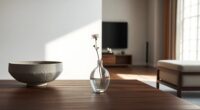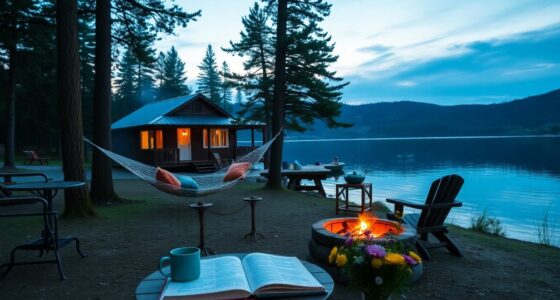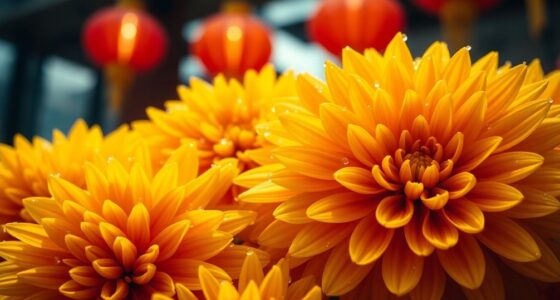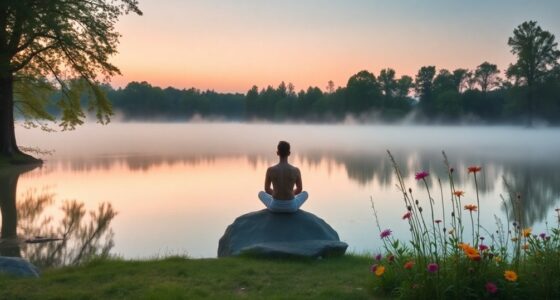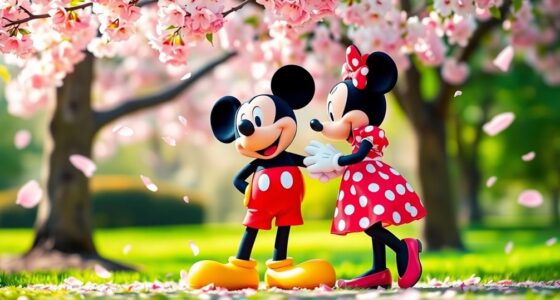A design retreat can turn your everyday space into a sanctuary that inspires and rejuvenates. Start by choosing a quiet location, free from distractions, and fill it with natural light and comfort. Use soft colors and calming furnishings like plush chairs and cushions to promote relaxation. Personalize the environment with art, quotes, and plants that uplift your mood. Keep the space organized and decluttered to enhance tranquility. Incorporate elements that encourage connection and creativity, ensuring a balance between work and leisure. There's so much more to explore to create your perfect retreat, so let's uncover additional insights together.
Key Takeaways
- Choose a quiet, comfortable location with natural elements to foster relaxation and enhance mindfulness during the design retreat.
- Personalize the space with artwork, cherished photographs, and inspirational quotes to evoke joy and motivation among participants.
- Maintain a clutter-free environment to promote focus and tranquility, keeping only essential items in the retreat space.
- Incorporate plants and soothing water features to improve air quality, elevate mood, and reduce stress levels for attendees.
- Foster community through group activities and collaborative environments, enhancing creativity and professional development during the retreat.
Choose the Right Location

When you're planning a design retreat, choosing the right location is essential to guarantee a productive and peaceful experience.
You'll want a retreat location that's quiet and free from daily distractions. Look for spare rooms, secluded nooks, or even transformed balconies; size doesn't matter as much as the intention behind the space.
Prioritize comfort and accessibility to enhance the overall experience. Incorporating natural elements like plants or natural light can make the retreat location feel more inviting.
Additionally, ensure that the space encourages self-reflection and assessment, which is crucial for personal growth during the retreat.
Regularly assess and adjust your chosen space to confirm it remains conducive to relaxation and mindfulness.
Create a Calming Atmosphere
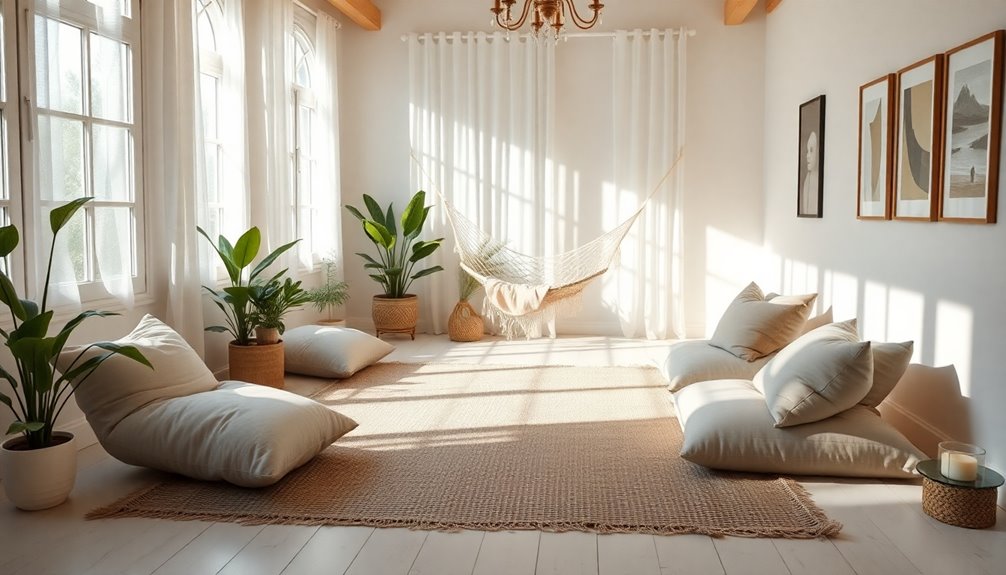
To create a calming atmosphere, start by choosing colors that promote relaxation, like soft blues and gentle greens.
Integrating natural elements, such as houseplants or small water features, can enhance the tranquility of your space.
These thoughtful choices work together to foster a serene environment perfect for unwinding. Additionally, serving traditional tea during gatherings can further elevate the soothing ambiance, encouraging mindfulness and connection among guests.
Color Psychology Impact
Creating a calming atmosphere hinges on the strategic use of color. The right hues can greatly impact your mood and overall life experience. Soft blues and gentle greens lower heart rates, while warm neutrals create a cozy vibe. Here's a quick guide to colors that promote tranquility:
| Color | Effect on Mood |
|---|---|
| Soft Blue | Reduces anxiety |
| Gentle Green | Promotes serenity |
| Warm Neutrals | Enhances comfort |
| Soft Lighting | Boosts relaxation |
Incorporating these colors into your space can foster a nurturing environment, making it feel inviting. Remember, the color psychology impact is powerful—choose wisely to create your personal sanctuary. Additionally, using skincare routines that incorporate calming elements can further enhance your overall relaxation and well-being.
Natural Elements Integration
Integrating natural elements into your retreat space not only enhances its aesthetic appeal but also fosters a deep sense of tranquility. By incorporating houseplants, you improve air quality while establishing a connection to nature that calms the mind.
Small water features, like tabletop fountains, add soothing sounds that promote relaxation and mindfulness. Use soft, warm lighting—think candles or Himalayan salt lamps—to create a serene ambiance perfect for unwinding.
Choose calming colors, like gentle greens and soft blues, to evoke tranquility and support reflection. Finally, natural materials like wood and stone in your furnishings ground the atmosphere, enhancing the overall well-being of your space.
Incorporating energy-efficient systems, such as heat pumps, can further enhance comfort while minimizing environmental impact.
Embrace natural elements integration for a rejuvenating retreat that inspires peace.
Invest in Comfortable Furnishings

When you invest in comfortable furnishings for your design retreat, you set the stage for true relaxation and rejuvenation.
Opt for plush chairs and meditation cushions that encourage unwinding and help you disconnect from daily stressors. Surround your retreat area with soft cushions and cozy throws, inviting longer periods of relaxation and mindfulness practice.
If space is limited, consider multi-purpose or foldable furniture to maximize functionality without sacrificing comfort. If you're using a bedroom as a retreat, a comfortable bed is essential for enhancing your overall relaxation experience.
Incorporating natural materials like wood and bamboo in your furnishings further enhances the serene atmosphere of your retreat.
Prioritizing accessibility and comfort in your furnishings allows you to fully immerse yourself in a restorative environment, making your retreat a true haven for rejuvenation.
Personalize Your Space
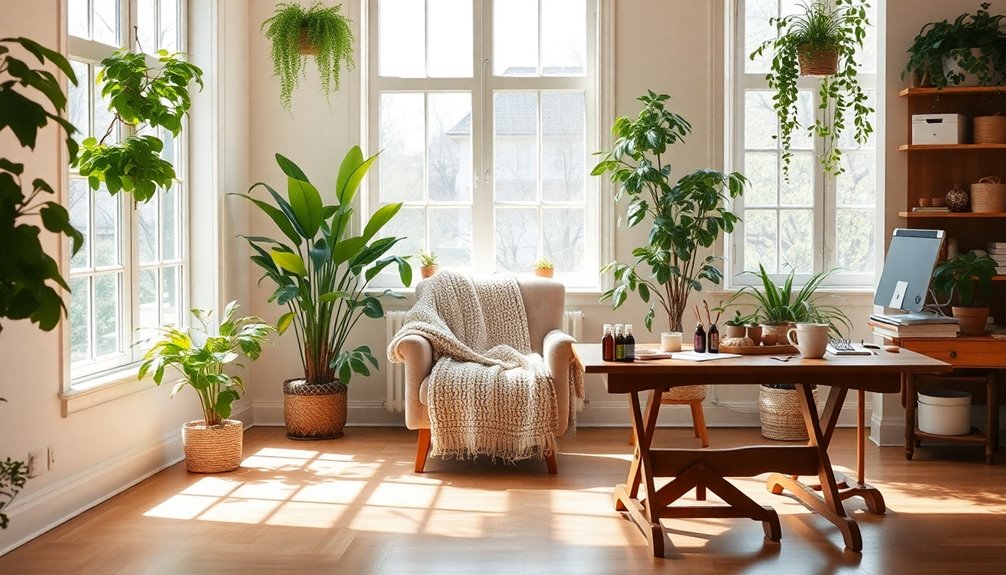
Comfortable furnishings lay the groundwork for relaxation, but personalizing your space truly enhances its inviting atmosphere. Add items that evoke joy—like artwork or cherished photographs—to deepen your emotional connection. Inspirational quotes or vision boards can motivate you daily and align your space with your aspirations. Consider creating a small altar for meditation, adding a spiritual touch while encouraging reflection. Incorporating natural materials in your decor can further enhance the warm, inviting atmosphere essential to a personalized retreat.
| Personalization Ideas | Emotional Benefits |
|---|---|
| Artwork | Evokes joy |
| Vision boards | Daily motivation |
| Cherished photos | Strengthens connections |
| Unique decor | Reflects individual taste |
| Meditation altar | Encourages tranquility |
When you personalize your retreat, you won't want to walk away from the space. It becomes a true sanctuary.
Declutter and Organize

A clutter-free environment is essential for cultivating a peaceful retreat space, allowing you to unwind and relieve stress more effectively.
To achieve this, regularly declutter and organize your surroundings. Start by removing distractions and non-essential items, which can greatly enhance your focus and tranquility.
Keep only the essentials, like books or relaxation tools, to guarantee your space remains functional and promotes mindfulness. An organized retreat space not only makes it easier to find what you need, minimizing interruptions during your relaxation time, but it also reflects your personal values and intentions.
This tidy environment fosters a sense of calm, making your retreat more inviting and rejuvenating. Embrace simplicity, and watch your space transform into a true sanctuary. Incorporating sustainable materials in your decor can also enhance the serenity of your space while being environmentally conscious.
Incorporate Natural Elements

Incorporating natural elements into your retreat can transform your space into a sanctuary.
By adding plants and small water features, you'll not only enhance the aesthetic but also promote relaxation and well-being.
Embracing biophilic design connects you with nature, creating an inviting atmosphere that rejuvenates your spirit. Additionally, including Indonesian decor masks can further enrich your space by adding cultural significance and unique artistry.
Benefits of Biophilic Design
When you integrate natural elements into your living or working spaces, you tap into the profound benefits of biophilic design.
Studies show that exposure to nature can lower cortisol levels by up to 15%, greatly reducing stress. By incorporating plants and natural light, you'll enhance cognitive function and creativity, potentially boosting workplace productivity by 15%.
Using natural materials like wood and stone not only adds beauty but also fosters a comforting connection to the outdoors.
Additionally, biophilic design can lead to a 6% increase in occupant satisfaction and a 13% reduction in absenteeism. Incorporating music therapy into your space can further enhance relaxation and well-being.
Embracing these principles creates environments that promote well-being, making your spaces not just functional, but truly inspiring and rejuvenating.
Integrating Plants and Water
Integrating plants and water features into your retreat space not only enhances the aesthetic appeal but also greatly boosts your well-being.
Studies show that having greenery around improves air quality and elevates your mood, reducing stress levels markedly. Consider adding houseplants like snake plants, peace lilies, or pothos, which are easy to care for and visually appealing.
A small fountain or aquarium can introduce soothing sounds, encouraging relaxation and mindfulness. Combine these elements with essential oils from plants for an invigorating sensory experience. Additionally, incorporating educational toys can stimulate creativity and promote a playful atmosphere, enhancing the overall experience of your retreat space.
Foster Connection and Community

Fostering connection and community during design retreats is essential for enhancing your overall experience and well-being. Social support plays a vital role in personal growth, and engaging in group activities encourages interaction, helping you build lasting relationships within the design community.
Before the retreat, using technology for pre-engagement lets you connect and share experiences, creating a supportive network. Once you're at the retreat, in-person group immersions provide valuable opportunities for networking and collaboration, paving the way for future partnerships.
Measuring community engagement outcomes guarantees you leave with a stronger sense of connection, promoting ongoing growth and collaboration beyond the retreat. By prioritizing these connections, you enrich not just your retreat experience but your professional journey as well.
Frequently Asked Questions
What Is a Rejuvenate Retreat?
A rejuvenate retreat is an experience focused on enhancing your mental, emotional, physical, and spiritual well-being.
You'll engage in intentional programming designed for personal growth and self-reflection, helping you set individual intentions for transformation.
These retreats often include mindfulness practices, healthy meals, and sensory activities to create a healing environment.
You'll also build connections with others, fostering a sense of belonging and support throughout your journey toward rejuvenation and lasting change.
How Would You Design the Upcoming Retreat?
To design an unforgettable retreat, you'll focus on fostering connection, igniting creativity, and enhancing relaxation.
You'll curate engaging sessions with industry leaders, arrange interactive workshops that spark innovation, and create serene spaces for reflection.
You'll prioritize personalized experiences, ensuring each participant feels valued and inspired.
Conclusion
Incorporating these elements into your design retreat can transform the space into a true sanctuary. Did you know that studies show spending time in nature can reduce stress by up to 60%? By choosing the right location and integrating natural elements, you're not just creating a visually appealing environment; you're fostering a sense of peace and rejuvenation. So, go ahead—design a space that inspires connection, creativity, and a little bit of magic for everyone who enters.

